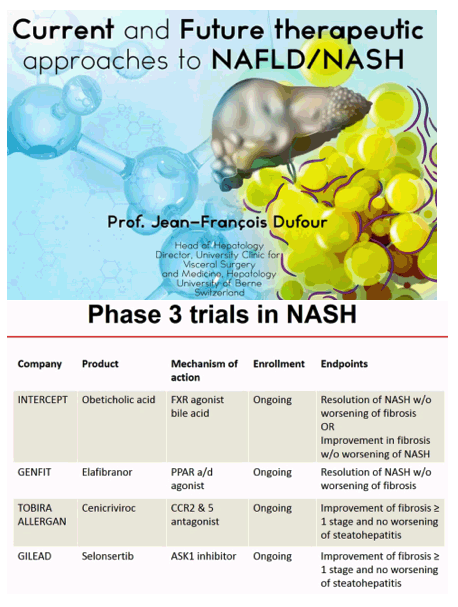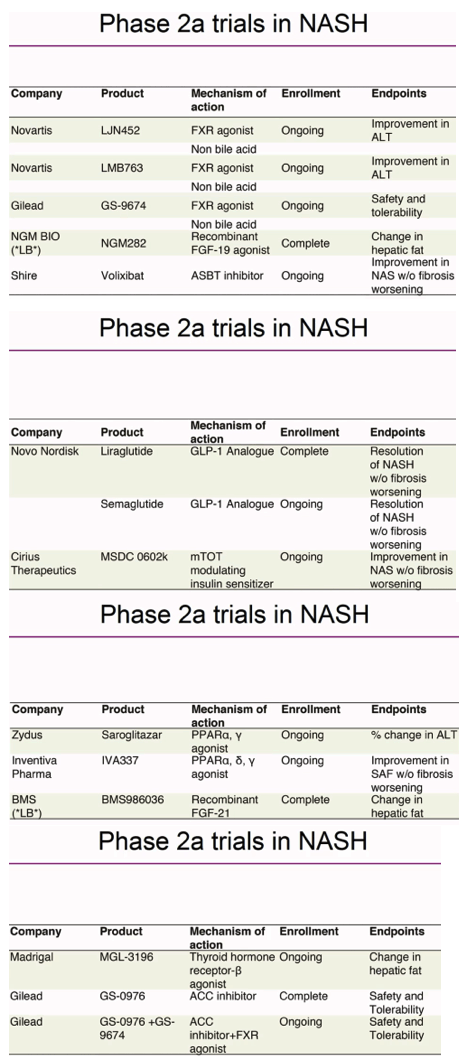 |
 |
 |
| |
Current and Future Therapeutic Approaches to NAFLD/NASH
|
| |
| |
from Jules: fatty liver & NASH appear to be more prevalent among HIV+, as they have many risk factors including metabolic abnormalities and elevated lipids, diabetes is a contributor; history of use of the old nucleosides were found to contribute to fatty liver.In the US & Globally its estimated around 30% have fatty liver. Diabetes is a major contributor to development of fatty liver. Fibrosis appears to be a major affect of fat in the liver and the development of fibrosis appears to be a strong driver of serious disease progression; as fibrosis progresses risk increases. Liver biopsy is now the main diagnosis test but imaging methods & non-invasive blood tats are being researched including the Fibroscan is being used as a noninvasive diagnostic tool. Although obesity is a driving factor in fatty liver disease recent research finds lean people can develop fatty liver too. Awareness about fatty liver & NASH is low among primary care doctors & clinicians. One of the concerns is that for primary care doctors & HIV doctors & clinicians fatty liver is not on their radar, so elevated ALT/ASTs can be a sign that fatty liver is present but awareness of this is absent. So when HIV+ or others have elevated liver enzymes HIV doctors & others do not think to connect that it may be due to fatty liver and just write it off as "everyone with HIV has elevated ALTs". Right now exercise & diet are the key recommendations for treatment but new drug development is racing ahead as you can see in the tables below with many drug candidates at various stages of development.
Nonalcoholic steatohepatitis, or NASH, is expected to become the leading cause of liver transplants by 2020. Yet most people who have the disease don't even know it. That subtle, slow-moving process begins with the build-up of fat in the liver, a condition called nonalcoholic fatty liver disease, or NAFLD, because it is not driven by alcohol consumption. According to the U.S. Centers for Disease Control & Prevention, up to 20% of the American population has NAFLD, which occurs when fat makes up more than 5% of the liver. For many people, a fatty liver will never become a real problem. As Abdelmalek notes, "If you have isolated fat, you may live and die with your fatty liver and never know it." But a portion of that population-a number pegged at roughly 16 million people-will go on to develop NASH's telltale inflammation and scarring.
As nonalcoholic steatohepatitis, or NASH, stealthily becomes a leading cause of liver transplants, drug companies are racing to develop treatments.
EASL: Emerging Treatments for ASH & NASH - Rohit Loomba, MD / AASLD 2016 - (07/03/17)
In the United States, studies report a prevalence of NAFLD of 10 to 46 percent, with most biopsy-based studies reporting a prevalence of NASH of 3 to 5 percent. Worldwide, NAFLD has a reported prevalence of 6 to 35 percent (median 20 percent). NHANES reports that NAFLD affects 18% of obese adolescents with no metabolic abnormality "indicating that obesity and excess visceral adiposity are independently associated with increased risk of NAFLD in adolescents regardless of metabolic derangements. The major risk factors for hepatic fat and hepatic fibrosis development in NAFLD are well established - age >50 years, obesity, insulin resistance, type 2 diabetes. Significant & increasing healthcare costs are associated with fatty liver. Reported at EASL by Stanford group - hospital charges in California - hospital charges over time for patients with fatty liver disease doubled from 2009 to 2013 while remaining stable from 2005 through 2009; cirrhosis accounted for 25% of charges for NAFLD and for cirrhotic patients charges increased; Hispanics accounted for 34% and non Hispanic whites accounted for 50%, and 14% for non white non Hispanic of hospital encounters.
From CDC:
How common are NAFLD and NASH?
NAFLD is one of the most common causes of liver disease in the United States. Most people with NAFLD have simple fatty liver. Only a small number of people with NAFLD have NASH. Experts estimate that about 20 percent of people with NAFLD have NASH.1 Between 30 and 40 percent of adults in the United States have NAFLD. About 3 to 12 percent of adults in the United States have NASH.1



CROI: FATTY LIVER DISEASE: A GROWING CONCERN - - (04/12/17) a plenary talk by noted fatty liver expert Rohit Loomba from UCSD, Higher prevalence in HIV+ vs general population by 30-40%
"Significant fibrosis and hepatic steatosis are highly prevalent among HIV mono infected patients.At baseline 41% of the patients had significant steatosis (CAP > 238 dB/m) vs. 54% of the patients after 24 months (p = 0.023)
CROI: Changes in Liver Fibrosis and Steatosis in HIV Mono-Infected patients over 24 months - 50% have fatty liver at average age of 46 - (03/28/17)
CROI: LIVER STEATOSIS AND FIBROSIS IN AT-RISK EUROPEAN HIV-MONOINFECTED PATIENTS - 64% with steatosis among those who had elevated LFTs and/or metabolic syndrome and/or lipodystrophy - (03/28/17) Of 140 patients eligible for liver biopsy, the procedure was performed in 50 (35%). Histological analysis was available for 49 patients and found NAFLD in 76% and NASH in 47%.
Fatty Liver, NAFLD, NASH Definitions - (06/29/17)
Fatty Liver / NASH - A silent liver disease epidemic - (05/22/17)
|
| |
|
 |
 |
|
|